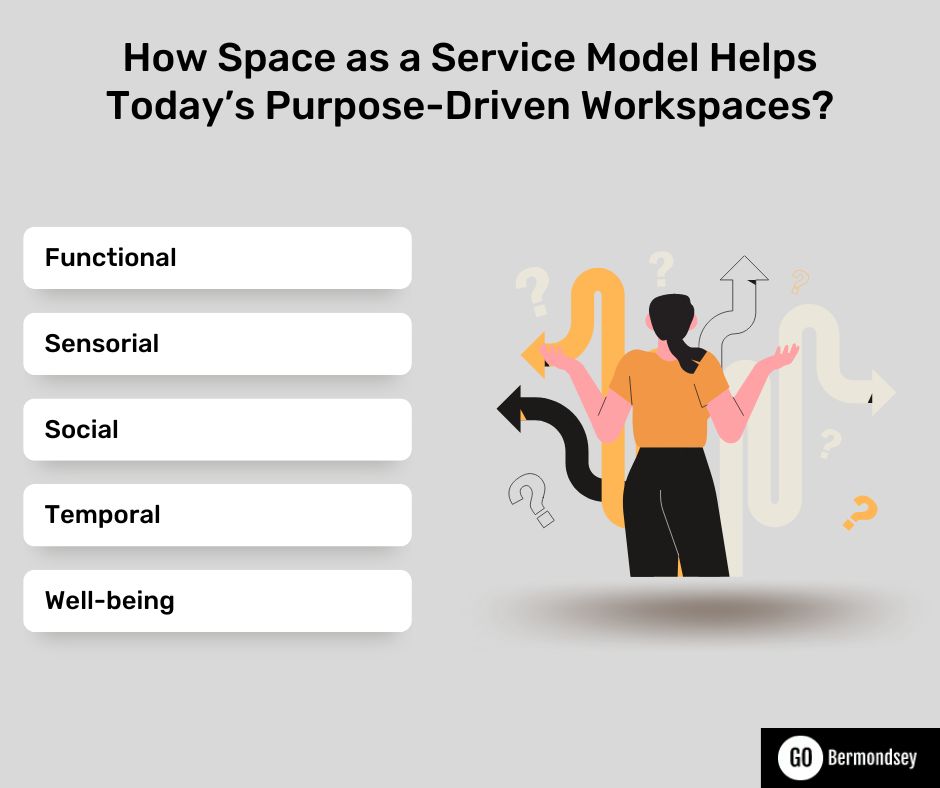Space-as-a-Service (SPaaS) is a revolutionary approach that’s transforming how we think about office spaces. Gone are the days of long-term leases and rigid office layouts. SPaaS offers a dynamic, adaptable environment tailored to your needs, fostering employee creativity, collaboration, and productivity. Whether you’re a start-up seeking a vibrant community that furthers your networking needs or a large corporation seeking scalable solutions, SPaaS provides the flexibility to grow and evolve in the modern age.
Here, we explore this new business model, its benefits, its role in facilitating purpose-driven workspaces, and how you can implement the Space as a service business model in office spaces.
What is Space as a Service?
Space as a service (SPaaS) is a modern business model that provides flexible, on-demand workspaces tailored to businesses’ evolving needs. Unlike traditional office leases or purchases, SPaaS offers short-term, scalable options that adapt to your business’s changing requirements.
The Space as a service business model supports productivity and innovation by allowing companies to expand or contract their workspace quickly. SPaaS is particularly beneficial for startups, freelancers, and growing businesses seeking cost-effective, adaptable solutions without the constraints of long-term commitments.
What Are the Benefits of Space as a Service?

Here’s a look at how SPaaS benefits businesses:
- Enhances Flexibility
SPaaS allows businesses the freedom to choose professional addresses and adjust their space utilisation as per their dynamic business needs. In the case of new hires, businesses can scale their workspace needs effortlessly. Similarly, if a business downsizes or adopts a remote-first hybrid workplace model, SPaaS allows it to reduce its office space without any hassle.
- Drives Business Focus
For businesses, the space as a service business model eliminates the task of managing the office space. You no longer need to hire facility managers or address workspace-related issues such as unstable WiFi, printer breakdowns, etc. All of this is managed by the SPaaS companies so that your business can concentrate on its core operations, driving growth and productivity.
- Offers a Cost-Effective Solution
The SPaaS model helps businesses access professional workspaces without having to commit to long-term leases or purchase property. This reduces the cost of operations and allows businesses to redirect their budget to other productivity-centric areas such as product development, talent hiring, etc. This is especially beneficial for startups and growing businesses that might have a limited budget.
- Offers Easy Scalability
The space as a service business model is adaptable by nature and allows businesses to scale their operations without hassle. It can accommodate fluctuating space requirements with ease and without requiring hefty monetary commitments.
- Provides Access to Amenities
SPaaS companies offer access to workspace amenities such as meeting rooms, printers, break rooms, audio and visual technology, etc. So, businesses get access to all the required professional amenities without having to manage them, pay high costs or make long-term commitments. This standout feature makes SPaaS companies a great partner for startups and growing businesses.
What Is an Example of a Space as a Service?
A practical manifestation of the space as a service business model would be a professional workspace where entrepreneurs, freelancers, and small business owners could leverage the offerings of a workspace without having to sign long-term contracts.
The SPaaS business model offers professionals everything they need, whether it’s high-speed internet, private meeting rooms, or basic office amenities like printers and scanners. All without the hassle of setting up the office and long-term leases.
But what truly sets SPaaS apart is that it doesn’t just offer professionals a desk and a chair but also gives them access to a vibrant professional community to further collaboration goals. Its flexible approach caters to the evolving needs of modern professionals, making businesses more adaptable and innovative.
The Rise of SPaaS in the UK in 2024: A Future Ahead
In 2024, the rise of Space-as-a-Service (SPaaS) in the UK is transforming the way businesses approach office spaces.
This business model is particularly beneficial to startups and growing companies as it offers them access to professional, customisable workspaces at affordable rates. On the other hand, larger companies can find value in the flexibility SPaaS offers, allowing them to downsize without worry.
Further, with the growing demand for flexibility and autonomy, SPaaS helps employers meet this employee need without compromising on productivity. Lastly, shared workspaces foster innovation and networking, bringing together professionals from diverse backgrounds and industries.
Which Office Spaces Can Implement SPaaS Business Model?
Almost any office space can implement the Space as a service business model, making it an exciting option for a wide range of business environments. From bustling coworking hubs to corporate campuses, SPaaS can transform traditional offices into dynamic, adaptable workspaces.
While startups and freelancers benefit from the flexibility and community vibe, larger companies appreciate the scalability and cost-efficiency. By embracing this model, office spaces can foster innovation, collaboration, and growth, creating vibrant work environments that evolve with the times.
How Space as a Service Model Helps Today’s Purpose-Driven Workspaces?

Purpose-driven workspaces factor in a variety of elements to achieve a productive work environment. Here’s a look at these elements:
- Functional
The functionality of a workspace is critical to purpose-driven workspaces. By this, we mean the workspace must have ergonomic furniture and equipment that promotes employee health.
Designated areas for specific tasks, such as quiet rooms for head-down work and meeting rooms for collaborative tasks, must be offered. Further, employees must have easy access to all the necessary tools and resources they need to excel at their work.
- Sensorial
A sensory element in a purpose-driven workspace creates an environment that pleases all the five senses. This means it must have ample natural light, comfortable temperatures, and soothing colours, to enhance mood and focus.
Adding plants and artwork creates visual interest, promoting relaxation and creativity. This sensory approach fosters an environment conducive to productivity and well-being.
- Social
Some employees thrive in open workspaces, while others prefer private cubicles. Therefore, workspaces should include communal areas like break rooms to encourage interaction and foster innovation and teamwork, as well as private areas for focused individual work.
This flexibility allows employees to choose where they feel most productive, enhancing overall efficiency and satisfaction.
- Temporal
Flexible time management helps employees balance personal and professional commitments. Options like remote working or flexible hours accommodate individual needs while maintaining productivity. Allowing employees to choose when and where they work fosters a sense of autonomy, boosting morale and motivation.
- Well-being
Employee well-being is crucial for a productive workspace. A healthy work environment reduces stress and burnout, leading to higher job satisfaction and retention rates.
Prioritising a positive work culture, offering a comfortable work environment, autonomy in operation, and a choice of where to work within the office enhances morale, boosts productivity, and fosters a more engaged and motivated workforce.
Empowering Employees in A Flexible Office Space
While a flexible office environment offers businesses convenience, it also helps foster trust and engagement. By catering to individual needs and preferences, companies create purpose-driven workplaces that align professional development with business success.
Providing a variety of workspace options, from quiet, cosy areas for focused work to collaborative spaces for brainstorming, ensures everyone can find their ideal setting. Further, integrating technologies that streamline workplace management, such as meeting room or desk booking tools, minimises stress and wasted time.
Supporting employees’ emotional well-being through remote work and flexible hours promotes a healthy work-life balance and empowers them to thrive.
How To Implement Space as a Service Business Model in an Office Space? A Step-By-Step Guide
Here’s a quick step-by-step guide on how you can implement SPaaS or the space as a service business model:
Step 1: Conduct Research
The first step in implementing SPaaS is to thoroughly evaluate and analyse your existing office space and its capabilities. This involves examining your current setup and conducting comprehensive market research to understand your target market’s demand.
Assess the needs, preferences and trends of your customers. Identify market gaps and areas of opportunity by studying business models, core features and technological resources that your target market values. Doing this will help you gain a deep understanding of your market, facilitating informed decision-making and better space optimisation.
Step 2: Develop Your SPaaS
The next step involves focusing on your offering. When developing your SPaaS offering, choose flexible technologies that can help you keep pace with multiple customer needs. Further, communication lines should be open across your team, and feedback from employees should be encouraged. Doing this allows you to recognise issues and make adjustments before they grow into problems.
Step 3: Maintain and Make Necessary Upgrades as Required
Building on the previous step, make sure to keep feedback from clients and employees flowing. Apart from allowing you to identify bottlenecks and problems in time, it also offers you valuable insight into how you can improve your offering.
For instance, if your clients complain about the unavailability of meeting rooms, it could prompt you to find temporary partitions to make ad-hoc meeting rooms whenever required.
Space as Service in Garden Office Bermondsey
Space-as-a-Service (SPaaS) is transforming office spaces, offering flexibility and scalability, and fostering purpose-driven work environments. In the UK, SPaaS is on the rise, reshaping the way businesses approach workspace solutions. By eliminating rigid leases and enabling dynamic office configurations, SPaaS enhances creativity and productivity.
To implement the space as a service business model, businesses can partner with innovative workspace providers like Garden Office Bermondsey, where tailored, vibrant office solutions await. Located in the heart of London, Garden Office Bermondsey offers a range of flexible, state-of-the-art workspaces designed to inspire and adapt to your business needs.
Whether you seek private offices, meeting rooms or premium lounges, Garden Office Bermondsey offers it all. To know more about Garden Office Bermondsey, book a visit today!







